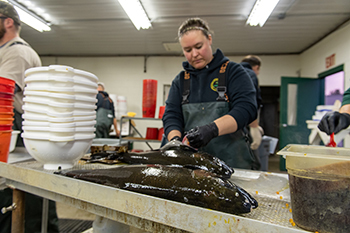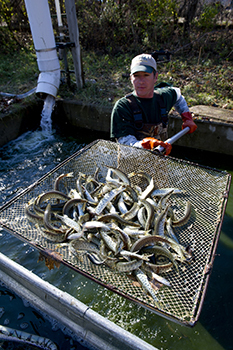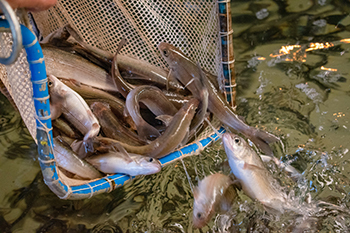Sunny days ahead – solar power coming to DNR state fish hatcheries
By DAN SAMPSON
Regional hatchery manager, Fisheries Division
Michigan Department of Natural Resources
As Michiganders, we truly love to get outside on sunny days, maybe for a day at the beach, a skiing trip with friends, boating on our favorite lake, bike riding on trails or camping at one of our beautiful state parks.
Regardless of what we have planned, the sunlight has a way of brightening our spirits and adding positive vibes to our lives, even on days when we seem just too busy to go out and truly unwind in it.

Michigan Department of Natural Resources fish hatchery staffers are no different when it comes to enjoying the sun. For hatchery managers, though, those sunny days will soon come with an extra silver lining.
Starting in 2023, solar panels will be installed at state fish hatcheries, contributing to paying the bills, producing electricity to help rear fish.
Starting in the southern part of the state in March and moving north through July, Solar Harvest, a solar energy company, will install solar arrays at five of the six DNR fish hatcheries.
Only the Marquette State Fish Hatchery in Marquette will be left out because nearby hills and trees block some light and reduce the amount of time solar panels could be producing electricity. This means that not enough electricity would be produced to offset enough power to make the investment worthwhile.
Luckily, though, that’s not the case at the other hatcheries.
Larger arrays
Three of the solar arrays will be the same size, each designed to produce 189.24 kilowatts and each offsetting power from Consumers Energy. These three larger arrays will be installed at the Wolf Lake, Harrietta and Oden hatcheries.
Although they will have the same design output capacity, the cost savings will vary due to site-specific physical factors and differences in electrical rates at each hatchery.
Projected annual energy cost savings are expected to be about $17,000 at Wolf Lake, $19,700 at Harrietta and $19,500 at Oden.
Wolf Lake State Fish Hatchery’s array installation will begin in March and is planned to be completed by early April. The location will be north of the production raceway building, paralleling Michigan Highway 43.
This array will be noticeable by hatchery visitors but will not be highly visible from the highway, due to trees along the north side of the property.
Wolf Lake’s solar array is expected to offset 17% of the main hatchery’s electricity needs and will pay for itself in 17 years.
|

Harrietta State Fish Hatchery’s array will be the next one installed, to be completed by the end of April. This one will be easily seen, with its location just west of the settling pond and in clear view of West 30 Road.
The location was selected because there is a steep, wooded hill just to the south of the hatchery that needs to be avoided. Harrietta’s solar array is expected to offset 18% of the main hatchery electricity needs and will have a payback period of 15.3 years.
Oden’s large array, one of two at this hatchery, will be installed in June. It will be situated in a sunny location just north of the brood stock building and will produce electricity for the main hatchery.
The site is well off South Ayr Road and will not be visible from the road, but visitors will be able to see it from the main hatchery. Oden’s large array is expected to offset 16% of the hatchery electricity needs and have a payback period of 15 years.
Smaller installations
Additionally, three smaller arrays will be installed at DNR hatcheries, including one at Platte River, one at Thompson and a second one at Oden. These arrays will vary in size and mounting style due to agreements with power companies and site conditions.
The Platte River State Fish Hatchery will receive a smaller, ground-based solar array by the end of May, which will offset power supplied by Cherryland Electric. This one is designed to produce 125.5 kilowatts for the main hatchery and is expected to produce enough energy to save the DNR about $13,000 per year.
The location for the array will be near the weir and salmon maturation ponds, visible to hatchery visitors but not noticeable from U.S. Highway 31. Platte’s array is expected to offset 12% of the hatchery electricity needs and has a payback period of 15.6 years.
The smaller of the two arrays at Oden State Fish Hatchery will be installed in late June. This one is designed to produce 51.46 kilowatts and is projected to save about $6,600 in energy costs per year.
It will supply a significant amount of the power needed to keep the viewing chamber dry, allowing visitors to watch what’s happening underwater in the stream at Oden State Fish Hatchery.
|

Additionally, it will offset electricity used in the isolation building, which is used to isolate new groups of fish that are planned to be used as future brood stock, including Arctic grayling.
The location for this array will be to the west of the isolation building, south of Oden’s big fishponds. It will not be visible from any road but will be somewhat visible to visitors who use the trail to the ponds.
The smaller array at Oden is expected to offset 76% of the electricity used from this meter and has a payback period of 13.8 years.
The sixth and final array will be installed at Thompson State Fish Hatchery in July. This one will be a roof-mounted system that is designed to produce 126.99 kilowatts of power and is expected to save about $13,000 annually.
Unlike the others, this array won’t be as noticeable because it will be mounted on top of the production raceway buildings, which are not easily seen from the road or hatchery grounds. Thompson’s array is expected to offset 16% of the main hatchery electricity use and has a payback period of 15.6 years.
Adding these six arrays will dovetail nicely with an existing 6-kilowatt array at the Oden State Fish Hatchery Visitor Center. Significant funding was provided for this array from by the Frey Family Fund via the Charlevoix County Community Foundation and Friends of Oden Hatchery, with construction completed in autumn of 2020.
This array reduced electricity supplied by Consumers Energy from a three-year average (2017-2019) of 11,423 kilowatt hours to a two-year average of 5,255 kilowatt hours and dropped the cost over those same time periods from $1,851 to $870.
Quite often, the array produces more power than the visitor center uses, which provides a credit to the monthly electricity bill. Because of this benefit, there were at least seven months in 2022 when the electric bill was under $30.
While the six new arrays won’t offer the same extremely low monthly bills, they certainly will make a significant dent in the DNR’s energy costs.
Big savings
Luckily, the stars seem to have aligned perfectly for these six solar projects to happen.
The need for an energy cost-reduction solution at the hatcheries is being met because solar technology advancements and availability happened to line up with bipartisan support from the State of Michigan’s executive branch and Legislature for creating a long-term solution to help address future hatchery energy expenses.
The investment is substantial. It is expected to produce 652,000 kilowatt hours per year, offsetting 16% of the overall hatchery electrical needs, saving the DNR almost $2.5 million over the next 25 years.
We’ve always loved those sunny days. Soon, there will be an extra silver lining each time the sun shines.
Find more information on the DNR’s fish hatcheries and weirs at Michigan.gov/Hatcheries.
|
Check out previous Showcasing the DNR stories in our archive at Michigan.gov/DNRStories. To subscribe to upcoming Showcasing articles, sign up for free email delivery at Michigan.gov/DNREmail.
Note to editors: Contact: John Pepin, Showcasing the DNR series editor, 906-226-1352. Accompanying photos and a text-only version of this story are available below for download. Caption information follows. Credit Michigan Department of Natural Resources, unless otherwise noted.
Text-only version of this story.
Browns: Brown trout egg take is shown at the Oden State Fish Hatchery.
Coho: Coho salmon egg take is shown at the Platte River State Fish Hatchery.
Grayling: Arctic grayling are being dumped from a net into a hatchery raceway at the Marquette State Fish Hatchery.
Muskie: A Michigan Department of Natural Resources staffer holds a mesh screen covered with muskellunge at the Wolf Lake State Fish Hatchery.
Solar: A solar array is shown at the visitor center at the Oden State Fish Hatchery.
Thompson: Walleye egg incubation is shown at the Thompson State Fish Hatchery.
|